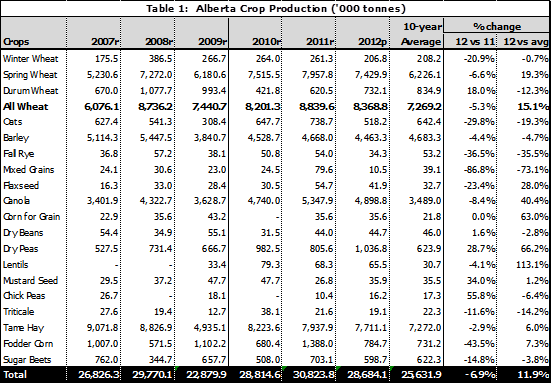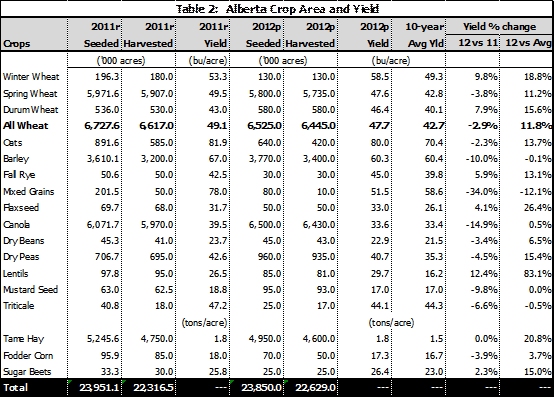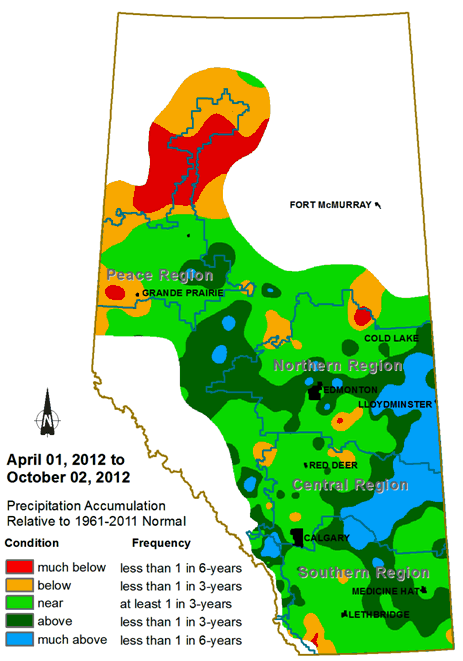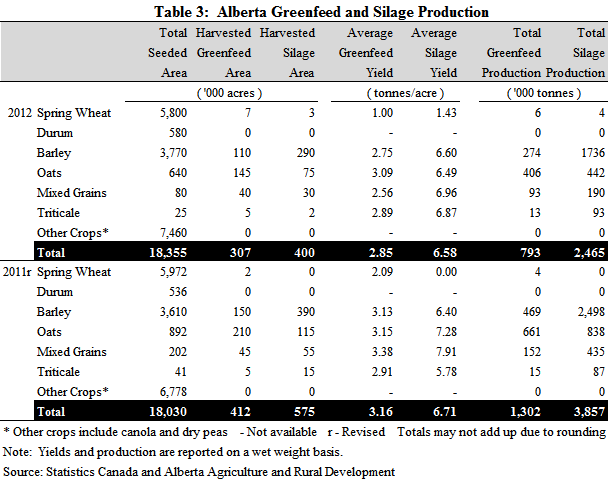| |
Insects and crop diseases | Forage and pasture | Alberta crop production, 2012 | Alberta forage production, 2012 I Alberta crop production tables | Precipitation Map
Overview
This report presents a review of the crop season and an analysis of crop production statistics for 2012. In addition, a precipitation map for the 2012 crop season is attached for reference.
The 2012 Crop Season
Crop growing conditions in the province during 2012 were mainly favourable. Producers were off to a slow start across the province given a wet cool May, but the reminder of the season was hot and dry with occasional precipitation which provided producers the opportunity to make good harvest and crop of average quality. Provincial average yields were above their respective 10-year averages. However, there was some crop damage due to adverse weather and crop diseases.
In 2012, seeding was later than normal across the province. The cool temperatures and several precipitation events in the May have resulted in crop development falling behind. The province surface soil moisture ratings were high throughout the spring, benefiting from several precipitations. Excessive moisture was a problem in Peace Region, with over 60 per cent surface soil moisture rated as excessive. Provincial seeding progress, as of May 17, 2012, was estimated as 55 per cent complete, compared to 80 per cent in most years.
In June, the province received more precipitation that ranged between 10 mm and 120 mm. Despite the challenging conditions earlier that year, producers were able to complete seeding by early June. By mid-June, scattered hailstorms were reported in the Southern, Central and North West Regions. For the most part, the hail damage was minor, but localized areas in the Southern Region did experience severe damage. Overall, crop development was mostly delayed due to cool weather and excessive moisture. Warmer weather was essential to further advance crop development. Surface soil moisture conditions were reported at 84 per cent good to excellent as of June 26.
The warmer and dry weather in July and August allowed crops to advance quickly and caught up from earlier delays. Soil moisture conditions remained excellent in most areas of the province with the exception of Peace Region, where overall crop conditions declined, due to a lack of moisture. The warm weather was ideal for harvesting which started in mid-August, and was most advanced in southern Alberta. Provincially, five to six per cent of crops were harvested as of August 21. Spraying for bertha army worm and diseases such as Aster Yellows and Sclerotinia were reported in some areas of the province.
In September, some areas of the province experienced variable weather, with strong winds, scattered showers and cool temperatures affecting crops and slowing down harvest progress. Strong winds in mid-September caused a further loss to canola crops through shelling out of swathed crop.
Producers started to report lower yields than originally anticipated, due to diseases, shallow rooted crops and the impact of heat stress in July and August. As of September 18, 60 per cent of the cereal crops were in the bin. Also surface soil moisture conditions decreased from 84 per cent to 50 per cent as good to excellent.
By early October harvest was virtually completed. Overall, crop yields in the province in 2012 ranged from average to above average. In terms of crop quality, grade estimates for both cereals and oilseeds were average, mainly as a result of the heat stress in July and August, and diseases in late summer and fall.
Insects and Crop Diseases
With respect to pest infestations in 2012, the most noticeable damage was from cutworms, wireworms, flea beetles and gophers. These incidences happened especially in the Central, North East and Peace Regions. In Southern Alberta, some producers were spraying for diamondback moth early in the spring at crop emergence. However, they did not become a threat later in the season. Grasshoppers were a moderate problem in some areas in the Peace and Central Regions. Spraying for cabbage seed pod weevil occurred in southern Alberta at the canola flowering stage. Lygus bugs had lower incidences in 2012; however some spraying took place in canola, later in the season, in the Central Region.
Damp weather conditions in spring and early summer contributed to crop diseases in many areas later in the season. Many incidents of Sclerotinia and Aster Yellows were reported throughout the province, mainly in the Central, North East and North West Regions. There were also incidents of blackleg in the province, especially in the South and North West Regions. There was less ergot in cereals, despite the warm moist conditions at the flowering stage. Ergot was mostly found in the Central Region.
Forage and Pasture
In May, pasture showed a good start across the province due to adequate moisture conditions, especially in South, Central and Peace Regions. Provincially, May pasture was rated as two per cent poor; 16 per cent fair; 61 per cent good and 21 per cent excellent.
Throughout the summer, pasture ratings remained mostly unchanged, around 80 per cent as good to excellent. By September, the ratings decreased to 70 per cent as good to excellent due to the dry and hot weather as well as lack of moisture throughout July and August.
With respect to tame hay, production was down from 2011 due to a smaller harvested area. This was mainly as a result of favorable moisture reserves in early August. The dry and hot weather helped with progress of first cut haying operations, with quality rated as good to excellent. The second cut had some rain and quality was also rated as good to excellent.
Alberta Crop Production, 2012
Total 2012 Crop Production Increased in Alberta
On December 5, 2012, Statistics Canada released its report entitled "Production of Principal Field Crops, November 2012". Based on this report, total 2012 production of principal field crops in Alberta was estimated at 28.7 million tonnes, 6.9 per cent lower than in 2011, and 11.9 per cent above the 10-year average for 2002-2011 (see Table 1). The decrease in production was largely due to lower yields compared to 2011. Provincial average yields were mostly above their respective 10-year averages (see Table 2). Crop growing conditions in the province during 2012 were mainly favourable. Seeding was later than normal given a wet cool May, but the reminder of the season was hot and dry. These conditions provided producers with the opportunity to make good harvest and crop of average quality. However, there was some crop damage due to adverse weather and crop diseases. Total seeded area of principal field crops in the province declined less than one-half per cent from 2011, while harvested area increased by just over one per cent.
Production by Crop Type, Alberta
Total production of spring wheat declined 6.6 per cent, to 7.4 million tonnes in 2012, but still was 19.3 per cent above the 10-year average. The lower production was due to a decline in seeded and harvested areas and reduced yields. The provincial average yield was estimated at 47.6 bushels per acre, down 3.8 per cent from 2011, and harvested area dropped 2.9 per cent, to 5.7 million acres. For durum wheat, production increased 18.0 per cent, to 732,100 tonnes due to increases in seeded and harvested areas and yields. Regarding yields, the provincial average was estimated at 46.4 bushels per acre, up 7.9 per cent from 2011. Overall, total production of all wheat reached 8.4 million tonnes, a decrease of 5.3 per cent from 2011 and 15.1 per cent above the 10-year average.
In 2012, total barley production was 4.5 million tonnes, down 4.4 cent from 2011 as a result of lower yields. The provincial average yield was 60.3 bushels per acre, 10.0 per cent lower than in 2011. Seeded and harvested areas were up 4.4 and 6.3 per cent, respectively.
Total canola production fell 8.4 per cent to 4.9 million tonnes, but was 40.4 per cent above the 10-year average. The lower 2012 production was attributed to reduced yields, down 14.9 per cent to 33.6 bushels per acre, but still above the 10-year average. For 2012, seeded and harvested acreage was estimated at 6.5 million acres and 6.4 million acres, respectively (both record highs).
Total production of dry peas increased 28.7 per cent, to a record 1.0 million tonnes, due to substantial increases in seeded and harvested areas. The provincial average yield was estimated at 40.7 bushels per acre, 4.5 per cent lower than in 2011, but still above the 10-year average.
Total oats production was estimated to be 518,200 tonnes, a decrease of 29.8 per cent from 2011. This was attributed to a substantial reduction in seeded and harvested area as well as lower yields. The provincial average yield was 80.0 bushels per acre, down 2.3 per cent, but still well above the 10-year average.
2012 Crop Production, Canada
Based on the November estimates, total 2012 Canadian production was 18.9 million tonnes for spring wheat, 4.6 million tonnes for durum, 8.0 million tonnes for barley, 2.7 million tonnes for oats, 13.3 million tonnes for canola, and 2.8 million tonnes for dry peas.
Alberta Forage Production, 2012
Total tame hay production in Alberta in 2012 was estimated at 7.71 million tonnes, based on the Statistics Canada report “Production of Principal Field Crops, November, 2012”. This was down three per cent from 2011, and six per cent above the 10-year average. The lower production was a result of a decrease in seeded and harvested area.
Based on a survey conducted by the Statistics and Data Development Branch of Alberta Agriculture and Rural Development, total greenfeed production in the province declined 39 per cent from 2011, to 793,000 tonnes (Table 3). The lower production was attributed to a marked decline in harvested area and lower yields. For silage, total production was estimated at 2.5 million tonnes, down 36 per cent from 2011, due to a lower yield and harvested area.
Total area harvested for greenfeed declined 26 per cent from 2011, to 307,000 acres, while silage acreage decreased 30 per cent, to 400,000 acres. The mainly hot and dry crop growing conditions in 2012 contributed to lower greenfeed yields than in 2011. Barley and oats were the major crops harvested for greenfeed and silage production, although significant acreages of mixed grains, and some spring wheat and triticale were also taken off as forages.
Contacts
For additional information relating to this report, please do not hesitate to contact the subject area specialist.
Alberta Agriculture and Rural Development
Economics and Competitiveness Division
Statistics and Data Development Branch
Lukas Matejovsky
Crop Statistician
780-422-2887
Email: lukas.matejovsky@gov.ab.ca
Alberta Crop Production Tables



Precipitation Map

Source: Alberta Agriculture and Rural Development, Environmental Stewardship Division, Technology and Innovation Branch
 |
|